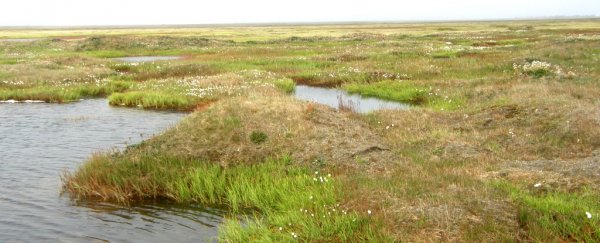Even as the Trump administration weighs withdrawing the United States from the Paris climate agreement, a new scientific paper has documented growing fluxes of greenhouse gases streaming into the air from the Alaskan tundra, a long-feared occurrence that could worsen climate change.
The new study, published in the Proceedings of the National Academy of Sciences, suggests that frozen northern soils - often called permafrost - are unleashing an increasing amount of carbon dioxide into the air as they thaw in summer or subsequently fail to refreeze as they once did, particularly in late fall and early winter.
"Over a large area, we're seeing a substantial increase in the amount of CO2 that's coming out in the fall," said Roisin Commane, a Harvard atmospheric scientist who is the lead author of the study.
The research was published by 19 authors from a variety of institutions, including NASA's Jet Propulsion Laboratory and the National Oceanic and Atmospheric Administration.
The study, based on aircraft measurements of carbon dioxide and methane and tower measurements from Barrow, Alaska, found that from 2012 through 2014, the state emitted the equivalent of 220 million tons of carbon dioxide gas into the atmosphere from biological sources (the figure excludes fossil fuel burning and wildfires).
That's an amount comparable to all the emissions from the US commercial sector in a single year.
The chief reason for the greater CO2 release was that as Alaska has warmed up, emissions from once frozen tundra in winter are increasing - presumably because the ground is not refreezing as quickly.
"The soils are warmer deeper, and as they freeze in the fall, the temperature of every soil depth has to come to zero before they hard freeze," Commane said.
"The temperature has to come to zero and equilibrate, for the soils to freeze hard through. And through that whole period you have emissions because the microbe are active."
In particular, the research found that since 1975, there has been a 73.4 percent increase in the amount of carbon lost from the Alaskan tundra in the months of October through December as the climate warmed steadily.
The new study is "the first to show that a large region of the Arctic is a carbon source and that this change is driven by increased carbon emissions during the winter," said Sue Natali, a permafrost researcher with the Woods Hole Research Center, who was not involved in the study.
"Because the models aren't capturing these cold-season processes, we're very likely underestimating carbon losses from the Arctic under current and future climate scenarios."
The fears about permafrost carbon losses are based on some simple chemistry.
Unlike at warmer latitudes, where microorganisms in the soil constantly break down plant matter and return the carbon it contains to the atmosphere, Arctic soils have been cold enough to preserve the frozen remains of ancient plant life.
But as the planet warms, soil microbes become able to break down more and more of this carbon, sending it back into the atmosphere and worsening global warming in a troubling feedback loop.
Some scientists, however, held out hope that there would be a key offsetting process: As the Arctic warms, it might also stow away more carbon as it becomes greener and supports the additional plant life, particularly in tundra regions.
This 'Arctic greening' is indeed occurring, but the new research suggests that the permafrost losses in early winter are more than enough to offset that.
"There is greening going on, but it seems like you run out of the sunlight so far north, so it doesn't matter how much greening there is, eventually, the plants just run out of light," Commane said.
"It appears now that the microbes are winning."
The new study contrasts with a 2016 study by the US Geological Survey, which had found that Alaska was acting as a net carbon "sink" at the moment - removing more carbon from the air than it is emitting - and that this should continue and expand over the course of the century as plant growth increases.
One of the lead authors of that research, Dave McGuire of the University of Alaska at Fairbanks and USGS, said the new study is "not the final word, but it is a significant step forward."
McGuire pointed out that the new study looks at the years 2012 to 2014, whereas the 2016 USGS study looked at earlier years and ended in 2009, making an 'apples to apples' comparison difficult.
Alaska is only one area of the Arctic where permafrost soils could be emitting carbon dioxide into the atmosphere. Permafrost regions in Canada and Siberia are even vaster.
But the new study's lessons could also apply to those areas, researchers say.
The study "shows that the Alaska region, which may be representative of large swaths of boreal forest and Arctic tundra biomes elsewhere, appear to be releasing net carbon to the atmosphere, in particular with stimulated emissions in the fall/early winter period," said Ted Schuur, an ecologist at Northern Arizona University, who was not involved in the research.
"We all knew this was coming, but I'm surprised that we can even see it now," Commane said.
2017 © The Washington Post
This article was originally published by The Washington Post.
